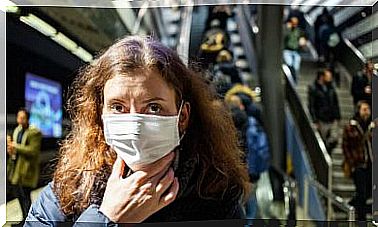Smoking Cessation: How To Approach Each Step?
Smoking cessation is the most relevant health action in terms of prevention. Its first step is to recognize the phase in which each smoker is in the process of smoking cessation.

According to the latest WHO report on global trends in tobacco consumption, the number of people addicted to tobacco is over 1.3 million. Consequently, health intervention for smoking cessation has become the benchmark for preventive actions.
Data from the World Health Organization shows that each year more than 8 million people die from tobacco use. This figure makes smoking the number one cause of death and preventable disease worldwide. This makes health intervention crucial for stopping smoking.
To be effective, this intervention must be able to manage physical and psychological dependence on tobacco, to break the automatism associated with the act of smoking and to modulate the influence of each person’s social environment on their consumption. The first step is therefore to recognize the phase in which the smoker finds himself within the process of smoking cessation.
The phases of smoking cessation

When we talk about smoking cessation, we must necessarily have recourse to the trans-theoretical model of change. A model created in 1982 by psychologists Prochaska and DiClemente with the aim of understanding and promoting the process of change when faced with a certain behavior.
In this process, there are six stages with very specific characteristics. Taking into account the possibility of going back and not having to go through all the phases. On the other hand, relapse is seen not as a failure, but rather as an opportunity to improve and increase the chances of success for a new attempt.
In this sense, the mission of the health professional will be to identify the phase of the change in which the smoker finds himself. Then adjust the interventions in order to motivate their progress in the process. In the rest of this article, we will go into each of the stages of smoking cessation in depth.
Pre-contemplation stage
At this point, even if the person knows that smoking is not healthy behavior, they are not yet aware of the problem it poses. Therefore, it also fails to recognize the need to stop smoking. Usually, we meet these people because they are consulting for another reason or because they have been pressured by those close to them.
The professional’s objective will be to make the person aware of the problem and to make him understand the importance of quitting smoking. To do this, it is essential to assess your level of knowledge about the risks of tobacco consumption. To inform her accordingly and to highlight the benefits she would derive if she stopped smoking.
Contemplation phase
During this phase, the person already knows that their problem is to quit smoking. However, even though she seems to want to do it in less than 6 months, she has mixed feelings about it or is not sure how to get it done. In other words, although she is aware of the problem, she doubts her ability to solve it.
At this stage, so that the smoker can move forward in his process of smoking cessation, the health professional will help him to put an end to his ambivalence. Therefore, it is essential to analyze and deepen in a personalized way the following aspects:
- Importance of stopping smoking for the smoker.
- Degree of confidence the smoker has to achieve this. It is therefore essential to promote self-efficacy by recalling other achievements made throughout one’s life.
- Risks associated with tobacco use and reasons why the person wants to continue to smoke.
- Benefits of quitting smoking and the difficulties in doing so.
Preparing to quit smoking

The preparation phase begins when the person has made a firm decision to quit smoking. The latter is convinced that she wants to quit smoking and is ready to give it a try within a month. At this time, the practitioner should:
- Congratulate and emphasize that quitting smoking is certainly the best decision that the person has made for their health and that of those around them.
- Choose a date from which the person will stop using tobacco (“D-day”). If the person has chosen to gradually quit, they must start earlier in order to completely quit smoking on D-day.
- Encourage the person to communicate their decision to all of their friends and family. The more people know, the better.
- Inform him of the appearance of any difficulties ( craving , irritability, anxiety, nervousness, fatigue, sleep disturbances, increased appetite, constipation, headache, difficulty concentrating, negative influence of the social environment, etc.) and work on useful strategies to relieve them.
The priority at this stage is to prepare the person to quit smoking. It is therefore fundamental to present the process to him as something positive. And to make her understand that she can quit smoking because she has the necessary strategies to successfully face any ordeal.
Tobacco cessation action
During this phase, the person has already quit smoking and their main goal is to remain non-smoker. To do this, the health professional should assess the difficulties encountered by the person and reinforce useful strategies to alleviate his problems.
In addition, it is important to remember that the abstinence syndrome begins to disappear from the seventh day. To also talk about the feeling of emptiness that occurs 10 days after quitting and to warn against the feeling of false security between 15 and 30 days after quitting.
Maintain 6 months without smoking

The maintenance phase begins when the person has not smoked for 6 months. We speak of ex-smokers only after 12 months without tobacco have passed. During this stage, the professional must reassess any difficulties and reinforce adaptation strategies.
On the other hand, it may be useful to recall the reasons for smoking cessation. And review the benefits that have already been manifested, and those to come. Also, it is worth remembering the downsides associated with smoking tobacco.
Smoking cessation: relapse
We talk about relapse when a person starts smoking again after quitting. At this stage, it is essential that the healthcare professional show empathy. May he give his support, refrain from any punitive behavior and encourage the person to take the relapse as a good opportunity to learn and to try again with more chances of success.









